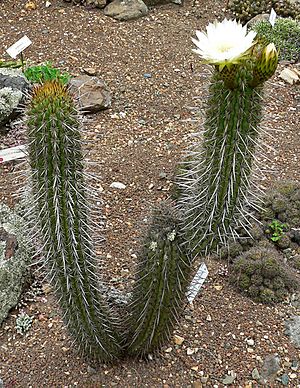Echinopsis chiloensis facts for kids
Quick facts for kids Echinopsis chiloensis |
|
|---|---|
 |
|
| Conservation status | |
| Scientific classification | |
| Genus: |
Echinopsis
|
| Species: |
chiloensis
|
| Synonyms | |
|
|
Echinopsis chiloensis is a type of cactus that grows naturally in South America. People sometimes call members of its family "hedgehog cacti," "sea-urchin cacti," or "Easter lily cacti."
About the Echinopsis chiloensis Cactus
This cactus, Echinopsis chiloensis, looks like a tree and can grow very tall. It can reach up to 8 meters (about 26 feet) high! It has many branches. Its main stems are round, about 10 to 12 centimeters (4-5 inches) wide. They have 16 to 17 low, wide ridges.
The cactus has bright yellow spines that turn gray as they get older. The main spines are straight and can be 4 to 7 centimeters (1.5-2.7 inches) long. Some can even grow up to 20 centimeters (nearly 8 inches). There are also 8 to 12 smaller spines around the main ones, measuring 1 to 2 centimeters (0.4-0.8 inches) or more.
The flowers of this cactus are shaped like a funnel and are white. They open during the day and can be up to 14 centimeters (5.5 inches) long. After the flowers, the cactus grows round, green fruits. These fruits are safe to eat. You can find this cactus in places like La Campana National Park in Chile.
-
An adult Echinopsis chiloensis plant at La Campana National Park.
-
The natural home of this cactus in La Campana National Park.
Where Echinopsis chiloensis Lives
Echinopsis chiloensis grows in central Chile, from the north to the south. It can be found in different areas. These include coastal regions, valleys, and even the foothills of the Andes mountains. It grows at elevations up to 1800 meters (about 5,900 feet) high.
The cactus was first described in 1826 by Luigi Colla. He called it Cactus chiloensis. Later, in 1974, scientists Heimo Friedrich and Gordon Douglas Rowley moved it to the Echinopsis group of cacti.
See also

- In Spanish: Quisco para niños








